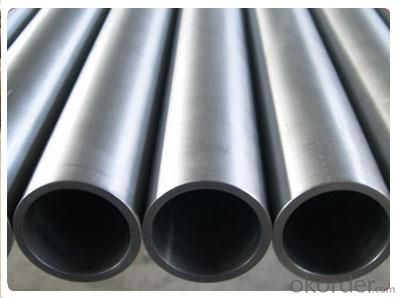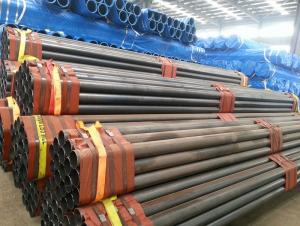seamless steel pipes from CNBM China to you
- Loading Port:
- Tianjin
- Payment Terms:
- TT or LC
- Min Order Qty:
- 25 watt
- Supply Capability:
- 8000 watt/month
OKorder Service Pledge
OKorder Financial Service
You Might Also Like
Seamless pipe possesses a hollow section and without seam around the strip steel. It is made with solid bar or steel ingot by perforating machine. As the facture process does not include any welding, seamless pipes are considered to be stronger and more durable. Generally speaking, seamless pipe has better pressure resistance and security than other classifications, and was usually more easily available than welded pipe.
2、Main Features of the Seamless Pipe:
• High working accuracy
• High strength
• Small inertia resistance
• Strong therming dissipine ability
• Good appearance
• Reasonble price
3、Seamless Pipe Specification:
Standard | GB, DIN, ASTM ASTM A106-2006, ASTM A53-2007 |
Grade | 10#-45#, 16Mn 10#, 20#, 45#, 16Mn |
Thickness | 8 - 33 mm |
Section Shape | Round |
Outer Diameter | 133 - 219 mm |
Place of Origin | Shandong, China (Mainland) |
Secondary Or Not | Non-secondary |
Application | Hydraulic Pipe |
Technique | Cold Drawn |
Certification | API |
Surface Treatment | factory state or painted black |
Special Pipe | API Pipe |
Alloy Or Not | Non-alloy |
Length | 5-12M |
Outer Diameter | 21.3-610mm |
Grade | 20#, 45#, Q345, API J55, API K55, API L80, API N80, API P110, A53B |
Standard | ASME, ASTM |
1) Material:20#(ASTM A 106/A53 GRB.API5LGRB,GB),45#,16Mn,10#.
2) Specification range: OD: 21.3-610mm, WT:6-70mm, length:6-12m or according to the requirement of clients.
3) Executive standards: GB, ASME API5L.ASTM A 106/A53,Despite of the above standards, we can also supply seamless steel pipe with standard of DIN, JIS, and so on, and also develop new products according to the requirements of our clients!
4) Surface: black lacquered, varnish coating or galvanized.
5) Ends: Beveled or square cut, plastic capped, painted.
6) Packing: bundles wrapped with strong steel strip, seaworthy packing.
4、Packaging & Delivery:
Packaging Details: | seaworthy package, bundles wrapped with strong steel strip |
Delivery Detail: | 15-30days after received 30%TT |
5、FAQ of Seamless Pipe:
①How is the quality of your products?
Our products are strictly in accordance with international and domestic standard. We test on every pipe before delivery. Any quality certification or testing report you want to see, please tell us.
Guaranteed: If products’ quality is not in accordance with description as we provide or the promise before you place order, we promise 100% refund.
②How about the price?
Yes, we are factory and be capable of offering you the lowest price. One of our policy is that “ to save time and be absolutely honest with our business relationship, we quote as low as possible for every client, and discount can be given according to the quantity”, if you are interested in bargain and dissatisfy our factory price, just don’t waste your time. Our quotation is professional.
③Why should you choose us?
Choice happens because of our quality and price. Additionally, we can also offer professional products inquiry, products knowledge train (for agents), fast goods delivery, outstanding customer solution proposals. Our service formula: good quality + good price + good service=customer’s trust.
SGS test is available. Customer inspection before shipping is welcome. Third party inspection is OK.
6、Seamless Pipe Images:




- Q: Can steel pipes be threaded?
- Yes, steel pipes can be threaded.
- Q: How are steel pipes used in the construction of offshore platforms?
- Steel pipes are extensively used in the construction of offshore platforms due to their durability, strength, and corrosion resistance. These pipes form the structural framework of the platform, providing support and stability. They are utilized for various purposes such as transporting fluids, including oil and gas, and for the installation of risers, which connect the platform to subsea equipment. Additionally, steel pipes are employed in the construction of pipelines and flowlines, facilitating the transportation of hydrocarbons from the platform to onshore facilities.
- Q: SC15 what does galvanized steel pipe look like?
- Zinc plating: galvanized steel pipe hot galvanized and galvanized two kinds, hot galvanized, zinc coating thickness, with uniform coating, adhesion, long service life and so on. The cost of galvanizing is low, the surface is not very smooth, and the corrosion resistance of itself is much better than that of galvanized pipe. Refer to
- Q: How are steel pipes protected against chemical corrosion?
- Steel pipes are protected against chemical corrosion through various methods such as applying protective coatings like epoxy or polyethylene, using sacrificial anodes, cathodic protection systems, or employing corrosion inhibitors in the pipeline system.
- Q: How are steel pipes used in the manufacturing of offshore wind turbines?
- Steel pipes are used in the manufacturing of offshore wind turbines for various purposes. They are commonly used to create the foundation structures, such as monopiles and jacket structures, which provide stability and support for the turbines in the seabed. Steel pipes are also utilized for the construction of the tower and nacelle structures, providing a strong and durable framework for the turbine components. Additionally, steel pipes are employed for the installation of subsea cables, allowing for the transmission of electricity generated by the turbines to the shore. Overall, steel pipes play a crucial role in the manufacturing of offshore wind turbines by providing the necessary strength, stability, and infrastructure required for their operation.
- Q: Can steel pipes be used for oil well casing?
- Yes, steel pipes can be used for oil well casing. Steel is a commonly used material for oil well casing due to its strength, durability, and resistance to corrosion.
- Q: How are steel pipes used in the telecommunications sector?
- Various purposes in the telecommunications sector commonly make use of steel pipes. Conduit for underground cable installations is the first purpose served by steel pipes. These pipes ensure the safety of fiber optic cables, which carry data and voice signals over long distances, by providing protection and support. The sturdy nature of steel pipes guarantees that the cables remain secure from external factors like moisture, rodents, and accidental damage. Furthermore, the construction of telecommunication towers and masts involves the use of steel pipes. A strong and durable material is required to bear the weight of antennas, transmitters, and other equipment in these structures. For this purpose, steel pipes are ideal due to their high tensile strength and resistance to harsh weather conditions. Additionally, steel pipes are utilized in the installation of overhead communication lines. These lines are often suspended between poles or towers, and steel pipes serve as supports or brackets to hold the cables in place. The corrosion-resistant properties of steel make it a reliable choice for outdoor installations exposed to various elements. In conclusion, steel pipes play a critical role in the telecommunications sector. They provide protection, support, and durability to cable installations, tower constructions, and overhead communication lines. Their strength and resistance to environmental factors make them an essential component in the establishment and maintenance of reliable telecommunications networks.
- Q: What are the different types of steel pipe bends?
- There are several types of steel pipe bends, including U-bends, J-bends, Miter bends, and Long radius bends. Each type serves a specific purpose and is designed to accommodate different flow requirements in piping systems.
- Q: Why should the weak electricity be pre buried with galvanized steel pipe?
- Galvanized steel pipe mainly because of anti-interference and electrical connectivity, to prevent other strong magnetic strong signal to interfere with weak signal, while in the electrical connection, galvanized steel pipe can be directly connected to the bridge.
- Q: How are steel pipes used in the construction industry?
- Steel pipes are commonly used in the construction industry for various purposes such as transporting fluids, structural support, and underground installations. They are utilized in plumbing systems, HVAC systems, and for conveying water, oil, and gas. Additionally, steel pipes are employed in the construction of high-rise buildings, bridges, and other infrastructure projects due to their durability, strength, and resistance to corrosion.
Send your message to us
seamless steel pipes from CNBM China to you
- Loading Port:
- Tianjin
- Payment Terms:
- TT or LC
- Min Order Qty:
- 25 watt
- Supply Capability:
- 8000 watt/month
OKorder Service Pledge
OKorder Financial Service
Similar products
Hot products
Hot Searches
Related keywords



























